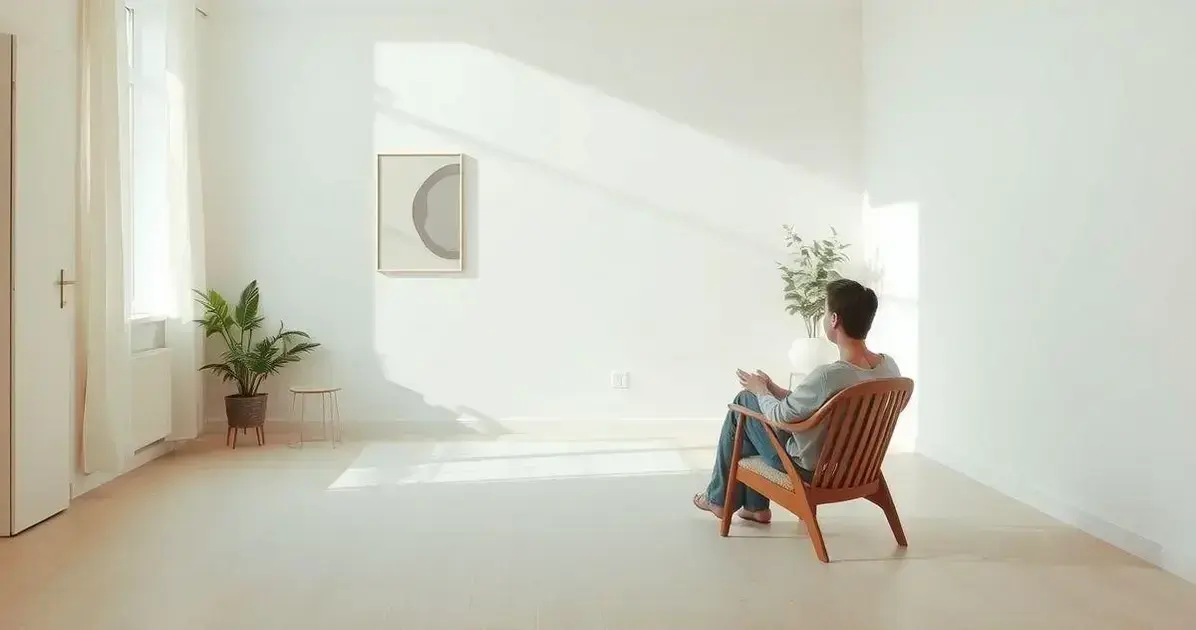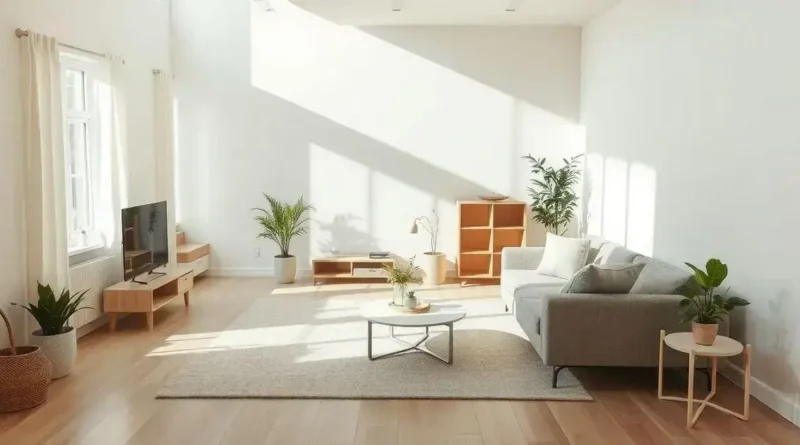Minimalist Lifestyle Tips: Transform Your Living Space and Mindset Today
Embracing a minimalist lifestyle can lead to profound changes in your daily life.
By focusing on what truly matters, you can declutter your physical space and mind, creating an environment that promotes peace and clarity.
In this blog post, we will discuss essential tips for achieving minimalism in various aspects of your life, including your home, wardrobe, and budgeting strategies.
Understanding Minimalism
Minimalism is all about simplifying your life by focusing on what really matters. This means getting rid of things that do not bring joy or serve a purpose. When you understand minimalism, you see it’s not just about owning fewer items; it’s about creating a more intentional way of living.
Living a minimalist lifestyle allows you to gain clarity and peace. It helps clear clutter from your home and mind. By reducing distractions, you can concentrate on your goals and relationships, leading to a more fulfilling life.
Moreover, minimalism encourages you to appreciate the small things. Instead of accumulating more possessions, you learn to find happiness in experiences and moments. This shift in mindset can lead to greater contentment and a sense of freedom.
Benefits of Minimalist Living
One of the main benefits of minimalist living is reduced stress. By simplifying your belongings, you create a more peaceful environment. A clutter-free space makes it easier to focus and relax, allowing you to enjoy your home without distractions.
Another advantage is saving time and money. When you live minimally, you spend less time cleaning and organizing. You also save money since you are less likely to buy unnecessary items. This gives you more freedom to invest in experiences that matter to you.
Finally, minimalist living fosters a greater appreciation for what you have. With fewer possessions, the things you keep become more meaningful. You start to recognize the value in simplicity, which can lead to a more grateful and fulfilling life.
Decluttering Your Home
Decluttering your home is a key step in embracing a minimalist lifestyle. Start by going through each room and identifying items that you no longer use or need. This could include clothes, books, or kitchen gadgets. If an item doesn’t add value to your life, it may be time to let it go.
To make decluttering easier, break the process into small tasks. Focus on one area at a time, such as a closet or a drawer. As you sort through your belongings, ask yourself if each item is essential. Keeping only what you love will make your space feel lighter and more organized.
Once you have decluttered, find ways to maintain that freshness. Create a habit of regularly evaluating your possessions. You could set a reminder every few months to reassess your belongings. Staying mindful of what you have helps keep your home serene and aligned with your minimalist goals.
Digital Minimalism

Digital minimalism is about using technology in a more intentional way. Instead of letting devices and apps distract you, focus on what truly benefits your life.
Start by assessing your digital habits and identifying the tools that add value while eliminating those that waste your time.
To practice digital minimalism, set limits for your screen time. This could mean turning off notifications or designating specific times for social media. By creating boundaries, you gain control over your online activities.
This helps you stay focused on your goals and enjoy more offline interactions.
Moreover, organizing your digital space can bring clarity. Delete unused apps and files that clutter your devices. A well-organized digital environment reduces stress and increases productivity.
Embracing digital minimalism not only enhances your focus but also allows you to appreciate real-life connections and experiences.
Minimalist Wardrobe Essentials
Building a minimalist wardrobe starts with choosing versatile pieces that you love and can mix and match. Begin with essentials like a classic white shirt, a pair of well-fitting jeans, and a simple black dress.
These items can be dressed up or down, making them suitable for any occasion. This way, you can create various outfits without a closet full of clothes.
It’s also important to focus on the quality of your clothing. Invest in durable fabrics that last longer and feel good on your skin. High-quality basics may seem expensive at first, but they save you money in the long run because you won’t need to replace them often. Look for timeless styles that won’t go out of fashion to keep your wardrobe fresh.
Finally, practice regular cleaning and organizing of your wardrobe. Set aside time each season to assess your clothing. Donate or recycle anything you no longer wear. This not only keeps your wardrobe tidy but also ensures that you only own what fits your minimalist lifestyle. A well-curated wardrobe makes getting dressed simpler and more enjoyable.
Mindfulness and Minimalism
Mindfulness and minimalism go hand in hand to create a more fulfilling life. Mindfulness is the practice of being present in the moment. When combined with minimalism, it helps you appreciate what you have rather than constantly seeking more.
By focusing on your surroundings and experiences, you can find joy in simplicity.
Practicing mindfulness can help you become aware of the clutter in your life. This includes physical spaces, digital distractions, and even mental clutter.
When you take the time to reflect, you can identify what truly matters and make deliberate choices about what to keep or remove. This clarity can significantly enhance your minimalist journey.
Moreover, incorporating mindfulness into daily routines can deepen your connections with others and yourself. For example, slow down during meals or take moments to breathe deeply throughout the day.
By being mindful, you nurture a sense of gratitude for what you have. This positive mindset supports your minimalist lifestyle and leads to a richer, more meaningful existence.
Creating a Minimalist Budget
Creating a minimalist budget starts with understanding your income and expenses. Begin by tracking where your money goes each month. Identify necessary expenses like housing, food, and transportation.
Once you know your spending habits, you can see what items are essential and what can be eliminated.
After outlining your expenses, prioritize your spending. Focus on what truly adds value to your life. For a minimalist budget, consider cutting back on non-essential items like dining out or subscription services. By choosing to spend less on things you don’t need, you create space in your budget for experiences and savings that enhance your lifestyle.
Lastly, regularly review and adjust your budget. Life changes, and so should your expenses. Set goals for saving, whether for a trip, an emergency fund, or investments.
A minimalist budget isn’t just about cutting costs; it’s about making room for what is meaningful and beneficial in your life, allowing for greater financial freedom.
Minimalist Lifestyle Tips: Final Considerations

To maintain a minimalist lifestyle, it’s essential to stay committed to your values and goals. Regularly assess your possessions and habits to ensure they align with your desire for simplicity.
This practice allows you to identify items or activities that no longer serve a purpose in your life, making it easier to declutter and refocus.
Establish daily routines that promote minimalism, such as tidying up each night or setting aside time for self-reflection.
By creating habits that prioritize simplicity, you can prevent clutter from accumulating in both your physical space and your mind. These routines help keep your environment serene and stress-free.
Finally, surround yourself with like-minded individuals who inspire and support your minimalist journey. Engaging with a community that shares your values can motivate you to maintain your lifestyle.
Remember that minimalism is a personal journey, and it’s okay to adjust your approach as needed to fit your life better.
Minimalism is more than just a style; it’s a way of living that helps bring clarity and joy to everyday life.
By choosing to live with less, you open up space for experiences and relationships that truly matter. This shift in mindset encourages you to let go of the unnecessary, making room for personal growth and happiness.
Adopting a minimalist lifestyle requires thoughtful decision-making. Every item in your life should serve a purpose or bring you joy.
This includes your possessions, daily routines, and even the people you spend time with. When you carefully consider what you bring into your life, you cultivate a more meaningful existence.
Lastly, practicing gratitude is essential in a minimalist lifestyle. By appreciating what you have, you keep focus on the value of simplicity.
This gratitude leads to contentment and helps you resist the urge to accumulate more. Living minimally reminds us that happiness often comes not from more, but from less.
